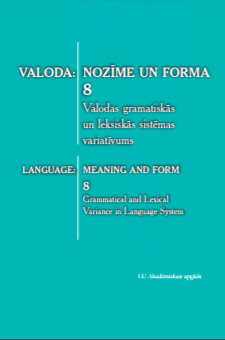Spatial deixis in Lithuanian: demonstrative pronouns
Spatial deixis in Lithuanian: demonstrative pronouns
Author(s): Gintarė JudžentytėSubject(s): Language studies, Lexis, Baltic Languages
Published by: Latvijas Universitātes Akadēmiskais apgāds
Keywords: binary system; exophoric demonstratives; experiment; Lithuanian; spatial deixis; spatial opposition; ternary system;
Summary/Abstract: This article deals with spatial deixis in Lithuanian (the issue of demonstratives). Spatial deixis is lexicalized by different parts of speech in different languages: by adverbs of place (e.g., here and there), verbs (come and go) and demonstratives. The demonstratives this and that are usually considered to be spatial deictics in their basic use. For instance, this house and that house indicate closeness to and distance from the speaker. This is called a proximal deictic and that – a distal deictic. Some languages have demonstratives with 3 and 4 way distinctions on the proximal-distal dimension. According to some Lithuanian authors, the Lithuanian language is among them and has a ternary system of demonstratives (deictic pronouns): šis is a proximal deictic, anas – distal, however tas can be used to indicate both – a proximal (‘near the speaker’) and distal (‘not near the speaker’) object in Lithuanian. The aim of this research is to verify whether the Lithuanian system of demonstratives is ternary as it is stated or whether it has changed. This paper deals with two problematic cases. Therefore, first, psychological distance is considered in spoken Lithuanian and, second, frequency of usage of the pronoun tas in face-to-face communication to indicate an object that is not close to the speaker instead of anas is evaluated.
Journal: Valoda: nozīme un forma
- Issue Year: 2017
- Issue No: 8
- Page Range: 173-193
- Page Count: 21
- Language: English

